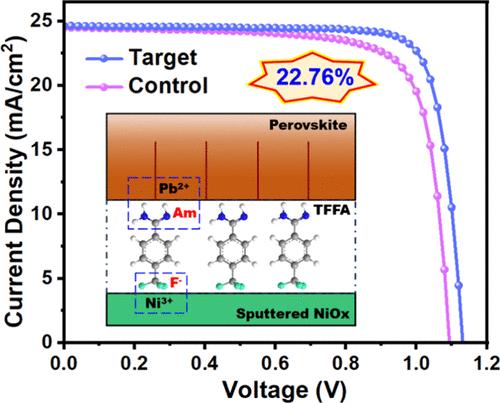磁控溅射氧化镍空穴传输层的表面性质调节,用于高性能反相包晶石太阳能电池
IF 8.3
2区 材料科学
Q1 MATERIALS SCIENCE, MULTIDISCIPLINARY
引用次数: 0
摘要
倒置型过氧化物太阳能电池(PSCs)具有前所未有的优势,如与串联和柔性设计更好地集成、可忽略的滞后、良好的运行稳定性以及与商业可扩展制造方法的兼容性,因此近年来正日益受到关注。采用磁控溅射技术制备的氧化镍(NiOx)薄膜具有极佳的可扩展性和可重复性,可以很好地满足大规模生产倒置式 PSC 的要求。然而,用真空方法制备的氧化镍一般表面羟基较少,会降低润湿性,破坏与包晶的界面接触。特别是在高温条件下,NiOx 表面的 Ni3+ 缺陷会导致与包晶石中的有机阳离子发生不利的氧化还原反应,从而促进包晶石的快速降解。因此,要想获得高性能的 PSC,就必须对溅射 NiOx 进行表面调控。本文采用 4-(三氟甲基)苯基氨基甲酸酯盐酸盐(TFFA)来调节溅射氧化镍的表面性质。TFFA 中的强电负性 F 离子钝化了 NiOx 表面的 Ni3+ 缺陷,抑制了不利的界面反应,改善了电荷重组。极性铵官能团用于调节 NiOx 的表面能,从而改善了润湿性并优化了过氧化物的结晶动力学。因此,PSCs 的功率转换效率(PCE)达到了 22.76%,是迄今为止报道的基于溅射氧化镍的倒置 PSCs 的最高 PCE 之一。此外,未封装的目标器件具有更好的稳定性,在氮气环境中老化约 1200 小时后,仍能保持 85% 以上的初始 PCE。我们的研究成果为提高溅射氧化镍基倒置式 PSC 的性能指出了一种实用的策略,有可能加速大面积 PSC 的开发和应用。本文章由计算机程序翻译,如有差异,请以英文原文为准。

Surface Property Regulation of a Magnetron-Sputtered NiOx Hole Transport Layer for High-Performance Inverted Perovskite Solar Cells
The inverted perovskite solar cells (PSCs) are gaining increasing attention recently for their unprecedented advantages, such as better integration with tandem and flexible designs, negligible hysteresis, good operational stability, and compatibility with commercially scalable fabrication approaches. Nickel oxide (NiOx) films prepared by magnetron sputtering technology exhibit excellent scalability and reproducibility, which could well meet the requirements of the large-scale production of inverted PSCs. However, NiOx prepared by vacuum methods generally has fewer surface hydroxyl groups, deteriorating the wettability and damaging the interface contact with the perovskite. Particularly, the Ni3+ defects on the NiOx surface could lead to unfavorable redox reactions with organic cations in the perovskite under high temperatures, promoting the rapid degradation of the perovskite. Thus, surface regulation of sputtered NiOx is imperative for high-performance PSCs. Herein, 4-(trifluoromethyl) phenylcarbamate hydrochloride (TFFA) was used to regulate the surface properties of sputtered NiOx. The strongly electronegative F ions in TFFA passivated the Ni3+ defects on the NiOx surface, suppressed unfavorable interface reactions, and improved charge recombination. The polar ammonium functional group was used to adjust the surface energy of NiOx, thereby improving the wettability and optimizing the crystallization kinetics of the perovskite. As a result, the power conversion efficiency (PCE) of PSCs reached 22.76%, which was among the highest PCEs reported for sputtered NiOx-based inverted PSCs to date. Moreover, the unencapsulated target devices exhibited better stability, maintaining over 85% of the initial PCE after aging for approximately 1200 h in a N2 environment. Our achievements pointed out a practical strategy for enhancing the performance of sputtered NiOx-based inverted PSCs, which could potentially accelerate the development and application of large-area PSCs.
求助全文
通过发布文献求助,成功后即可免费获取论文全文。
去求助
来源期刊

ACS Applied Materials & Interfaces
工程技术-材料科学:综合
CiteScore
16.00
自引率
6.30%
发文量
4978
审稿时长
1.8 months
期刊介绍:
ACS Applied Materials & Interfaces is a leading interdisciplinary journal that brings together chemists, engineers, physicists, and biologists to explore the development and utilization of newly-discovered materials and interfacial processes for specific applications. Our journal has experienced remarkable growth since its establishment in 2009, both in terms of the number of articles published and the impact of the research showcased. We are proud to foster a truly global community, with the majority of published articles originating from outside the United States, reflecting the rapid growth of applied research worldwide.
 求助内容:
求助内容: 应助结果提醒方式:
应助结果提醒方式:


